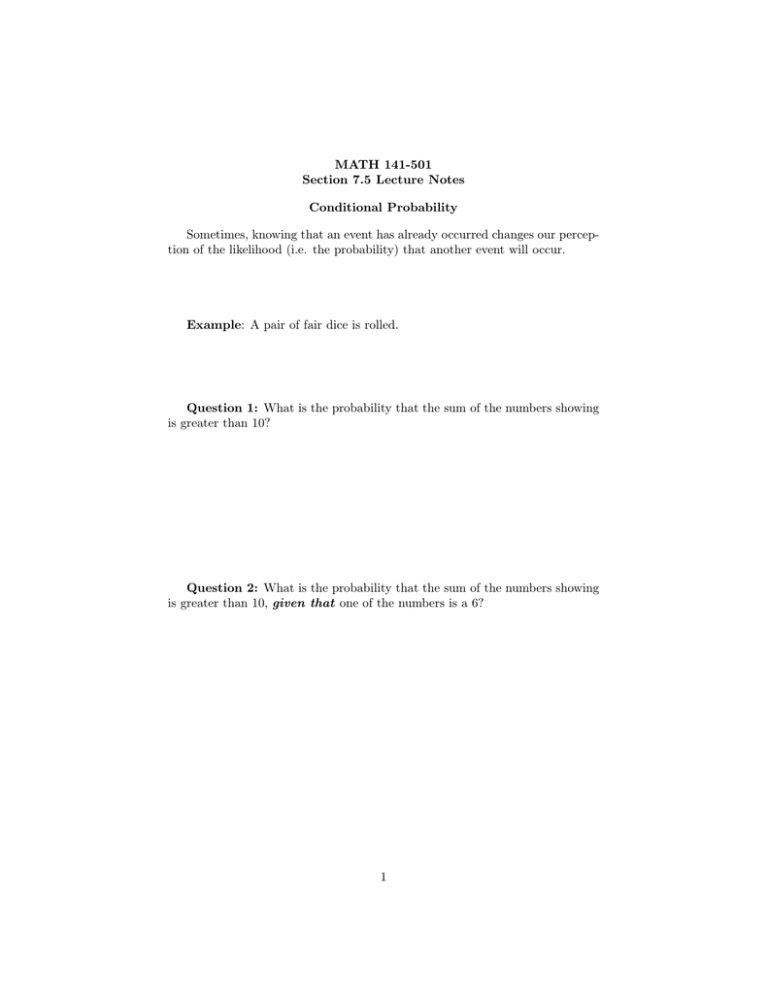MATH 141-501 Section 7.5 Lecture Notes Conditional Probability
advertisement

MATH 141-501 Section 7.5 Lecture Notes Conditional Probability Sometimes, knowing that an event has already occurred changes our perception of the likelihood (i.e. the probability) that another event will occur. Example: A pair of fair dice is rolled. Question 1: What is the probability that the sum of the numbers showing is greater than 10? Question 2: What is the probability that the sum of the numbers showing is greater than 10, given that one of the numbers is a 6? 1 Conditional Probability Definition: If A and B are events in a sample space S, the conditional probability of B given A, denoted P (B | A), is the probability that B will occur, given that we already know A has occurred. Formula for Conditional Probability: If A and B are events in an experiment and P (A) 6= 0, then the conditional probability that the event B will occur, given that the event B has already occurred is P (B | A) = 2 P (A ∩ B) . P (A) Example: Let A and B be two events in a sample space S such that P (A) = .61, P (B) = .49, and P (A ∩ B) = .2. Find... ...P (A | B) ...P (B | A) ...P (A | B c ) 3 Example (from textbook): Receiving Financial Aid Undergraduates Graduates Total 4,222 1,879 6,101 Not Receiving Financial Aid 3,898 731 4,629 Total 8,120 2,610 10,730 Let A be the event that a student selected at random, and let B be the event that a student selected at random is receiving financial aid. Find the following probabilities... ...P (A) ...P (B) ...P (A ∩ B) 4 Example (continued) : Receiving Financial Aid Undergraduates Graduates Total 4,222 1,879 6,101 Not Receiving Financial Aid 3,898 731 4,629 Total 8,120 2,610 10,730 What are the following probabilities? ... P (B | A) ... P (B | Ac ) Question: Are the events A and B independent events? 5 Product Rule If take the formula P (B | A) = we obtain the... P (A∩B) P (A) and multiply both sides by P (A), Product Rule: P (A ∩ B) = P (A) · P (B | A) In Words: The probability of A AND B is the probability of A times the probability of B given A. Multi-stage experiments and Tree diagrams A multi-stage experiment is an experiment which consists of several parts. The outcomes and probabilities at each stage could depend on what happened in previous stages. Tree diagrams (which we have seen before) are useful for solving problems related to these multi-stage experiments. Procedure for Drawing a Tree Diagram: I tried to think of a clear step-by-step description for how to create a tree diagram, but I couldn’t come up with anything which was brief and clear. Let’s do an example, and see if we can come up with a recipe for how to use these important tools. Example: (from textbook) An experiment consists of drawing two cards from a well-shuffled deck. What is the probability that the second card is a club? 6 Example (from textbook) A box contains seven batteries. Two of these batteries are defective. The batteries are taken out of the box randomly and tested until a nondefective one is found. (We do not put a battery back in the box after we test it.) Question: What is the maximum number of batteries that could be tested? Tree Diagram: Question: What is the probability that the number of batteries tested is... ...one? ...two? ...three? 7 Independent Events Independent Events - in words: A and B are independent events if the outcome of one does not affect the outcome of the other. Examples of Independent Events: Examples of Events Which are Not Independent: Independent Events - in math: If A and B are independent events, then P (A | B) = P (A) and P (B | A) = P (B). Test for the Independence of Two Events: Two events A and B are independent if and only if P (A ∩ B) = P (A) · P (B). Example: If A and B are events with P (A) = .25, P (B) = .6 and P (A ∩ B) = .18. • Are A and B independent? • Are A and B mutually exclusive? 8 Example & Test for Independence of More Than Two Events There may be times where we want to test if more than two events are independent. We can use the following rule. Test for Independence of More than Two Events: If E1 , E2 , . . . , En are independent events, then P (E1 ∩ E2 ∩ . . . ∩ . . . En ) = P (E1 ) · P (E2 ) · · · · · P (En ). Example: It is known that the events A, B, and C are independent. We know that P (A) = 0.25, P (B) = 0.45 and P (C) = 0.5. Compute P (A ∩ B ∩ C). 9





